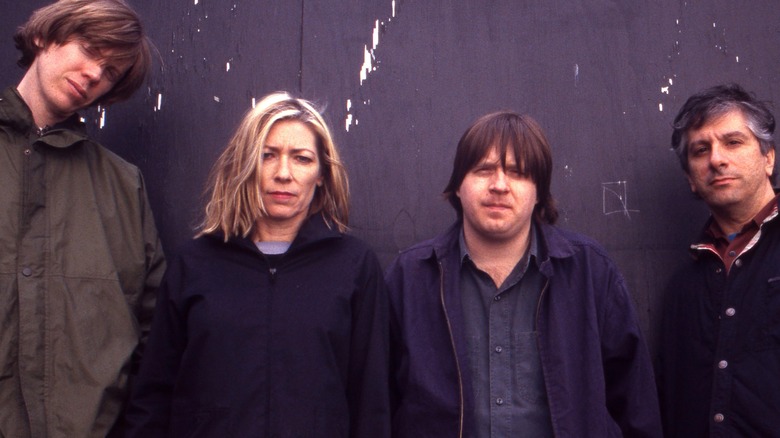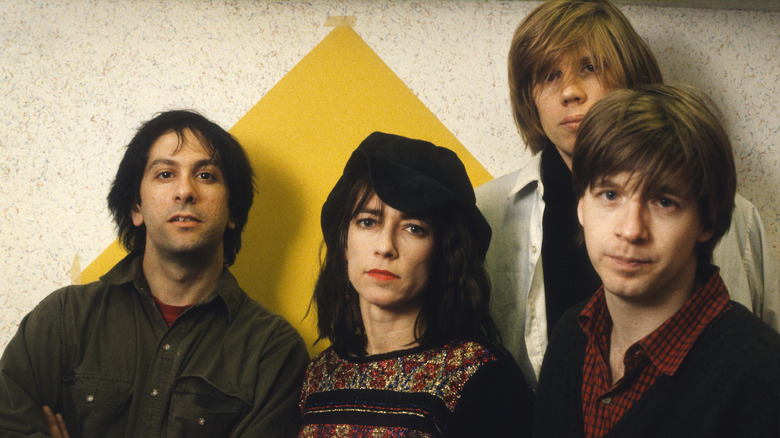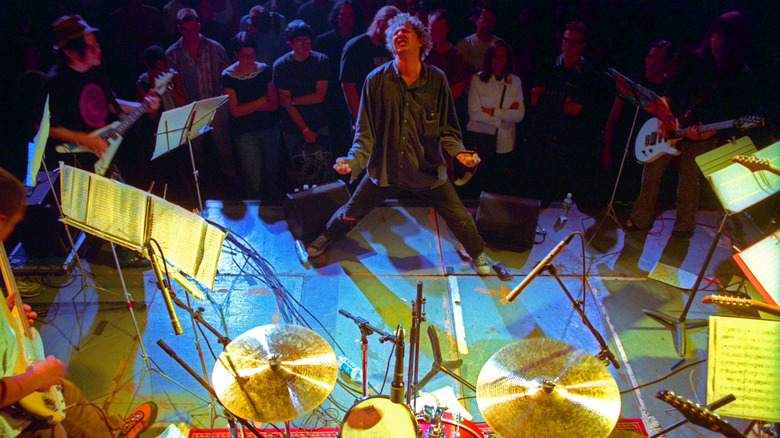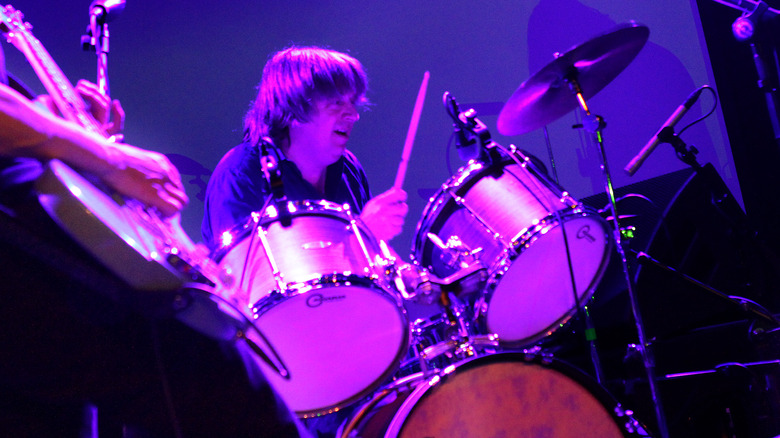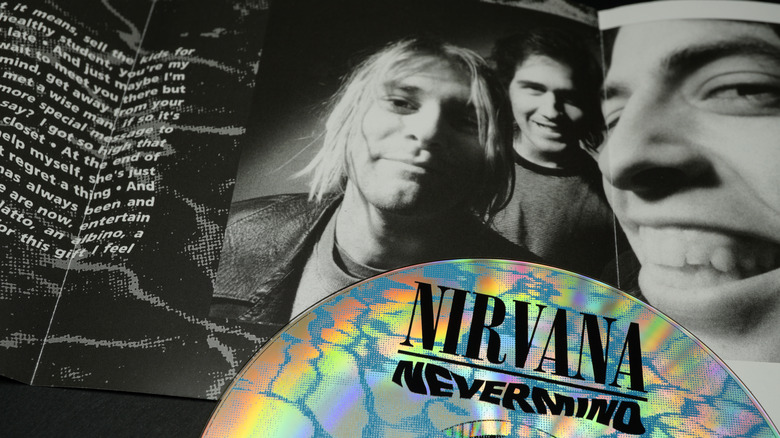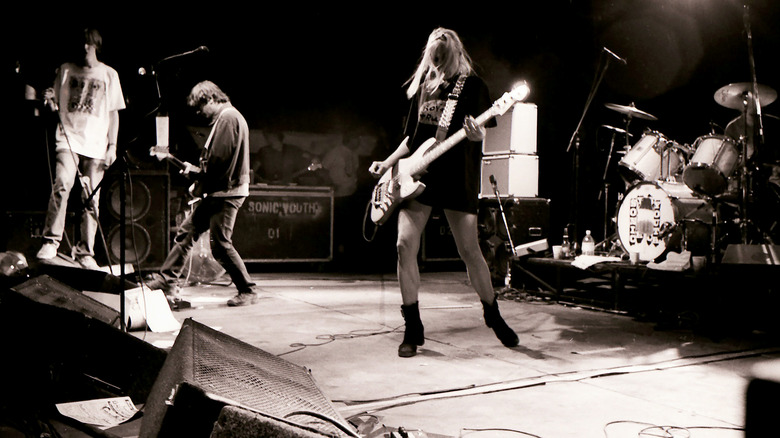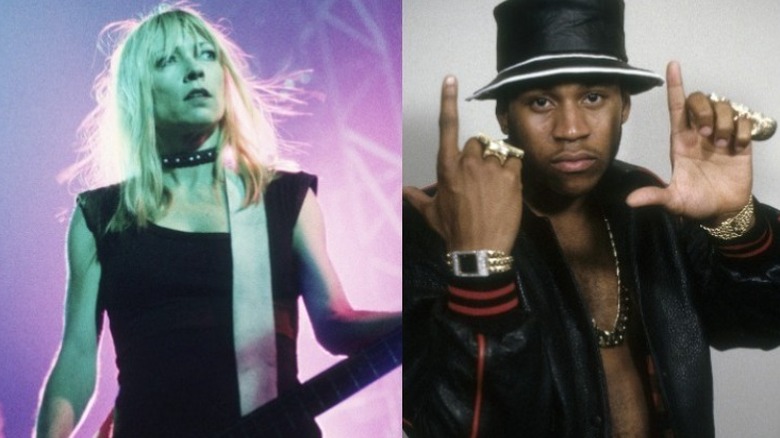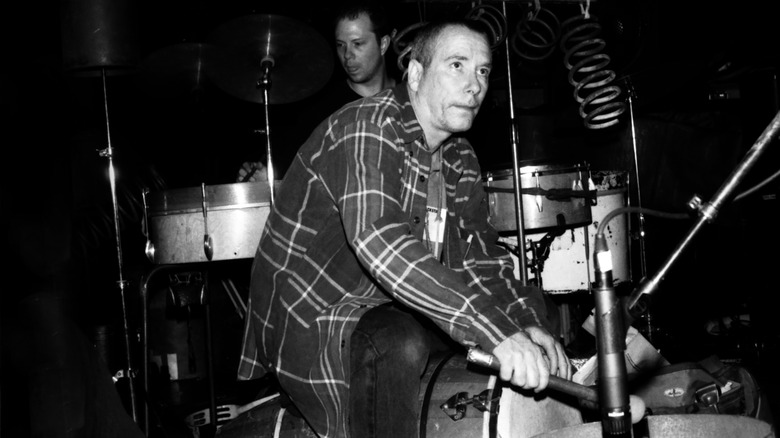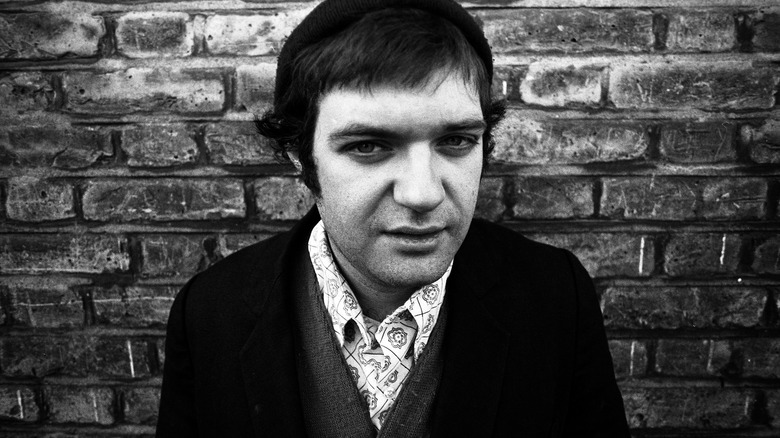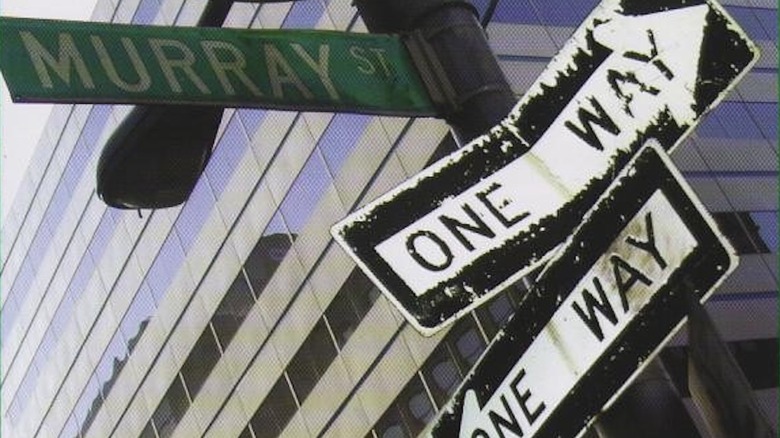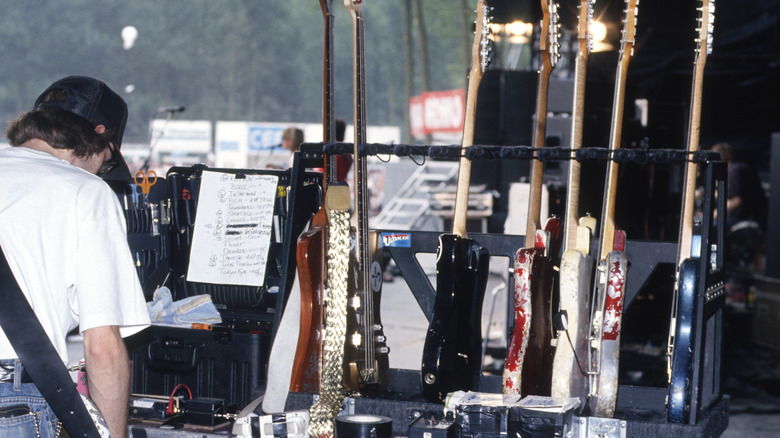The Untold Truth Of Sonic Youth
Rock icons, pioneers of experimental pop and noise, agents of some of contemporary music's most important moments and movements: Sonic Youth are tough to define and harder to understate. Born in the seedy, wild New York underground amidst an explosion of experimentation from the ripples of punk and conceptual art, Sonic Youth buzzed and hissed their way into the mainstream, ushering in a landscape ripe for friends like Nirvana and Sofia Coppola to make their own marks on human culture.
Expectedly, Sonic Youth's story has been as varied and intricate as their work, following periods of flowing harmony with jarring dissonance, ending in a bitter divorce that shocked the music world. With such a long history, pieces of the puzzle are frequently left out — the band's storied connection with contemporary art, the artists they propped up in their ascension to punk royalty, and Kim Gordon's outfits (yes, really). In the band's numerous official biographies and generous interviews lay hidden gems sure to tantalize even the most ardent and dedicated fans. Here's the untold truth of Sonic Youth.
Sonic Youth got their start in the No-Wave movement
In a memorable scene from 2007's "Juno," the titular character (played by Elliot Page), having just been inappropriately hit-on by Mark Loring (Jason Bateman), explosively declares "I bought another Sonic Youth album and it sucked ... it's just noise." Though meant mostly as a proxy of Juno's angst, such arrows have been slung at the band across their 30-year career. The critique is understandable given that noise is a hallmark of the band's sound. But to fully understand the noise's importance, one has to look back on Sonic Youth's origins.
As critic Marc Masters outlines in his book, "No Wave," (via Pitchfork) No Wave was a brief punk-adjacent movement (or anti-movement, to some), existing in New York City from the late 1970s to early '80s. The primordial ooze from which figures like Lydia Lunch and Suicide arose, No Wave was characterized by its opposition to everything happening around it, especially western song-structure and tonality. The result was a panoply of abrasive sounds, and chaotic flirtations with performance art which made forerunners like John Cage appear comparably conservative. Not long after things began, the scene's members began to disband, but not before giving birth to their best-known and longest surviving contributors, Swans and Sonic Youth, each of whom continued to carry No Wave's noise well into the 21st century, as per Treble.
Thurston Moore and Lee Ranaldo started in Glenn Branca's guitar orchestra
As many have described, 1970s New York was kind of a hellscape. Kevin Baker (via The Guardian) describes through his own account how decades of suburban flight and a national financial crisis turned America's crown jewel city into the perfect backdrop for Dystopian fiction. None of this stopped Sonic Youth's founders from going out of their way to become part of the city's burgeoning art and music scenes, writes David Brown in "Goodbye 20th Century." And, as Browne details, it wasn't long before founders Thurston Moore and Lee Ranaldo found themselves in the immediate orbit of a composer who built their entire career around the energy of New York's chaotic decay, Glenn Branca.
Like Sonic Youth, Branca was part of the noisy, short-lived No Wave movement. Branca's M.O., like his contemporaries, was to "emancipate punk from the aesthetic trappings of rock 'n' roll" (from Billboard). Early iterations of Branca's "guitar orchestra" became home to Moore and Ranaldo, who would use Branca's techniques — like playing guitars with power-tools — and ethos as an essential basis for the founding of Sonic Youth. When they began touring Europe with Branca, this too became part of the nascent band's toolkit. As Ranaldo recounts in a Redbull Academy interview, Branca's tours not only gave them international gigging experience, they also gained enough contacts to bypass the less-forgiving American underground circuit for most of their early years.
They've Had Five Great Drummers
Sonic Youth had a rare, largely unchanged line-up for most of their career. According to AllMusic, they officially formed in 1981 after founders Kim Gordon and Thurston Moore recruited Lee Ranaldo and started gigging soon after. Drummer Steve Shelley would round out the core group in 1985, but not before they cycled through a colorful cast, who each went on to have their own interesting careers.
As David Browne writes, their first drummer came and went in short time. Richard Edson — who later acted in acclaimed films "Do the Right Thing" and "Stranger than Paradise" (via IMDb) had a rather visceral introduction to the band when Thurston Moore casually bled on Edson's drum kit at his audition. After staying to record the band's eponymous debut, Edson left and was replaced by Bob Bert, who was then replaced by Jim Sclavunos, best known in Nick Cave & the Bad Seeds (from jimsclavunos.com).
According to the band's website, Sclavunos would co-write and record most of "Confusion is Sex" before choosing to quit mid-way through. To finish out the record, the band brought back Bert, who would remain in the band through 1985's "Bad Moon Rising," before amicably handing the reins to Steve Shelley.
Sonic Youth helped get Nirvana signed
It's hard to understate how important Sonic Youth have been to music, paving the way in one way or another for the success of such groups as Dinosaur Jr., Yeah Yeah Yeahs, and Sigur Rós, notes the BBC. As genuine music fanatics, their story is also one of taking others they believed in along for the ride, including a then little-known group from the Pacific Northwest called Nirvana.
In 1989, after having hopped between a number of indie labels, Sonic Youth was signed by Geffen Records. As described in Michael Azerrad's "Our Band Could Be Your Life," the move was unique among the band's contemporaries, many of whom had experienced horror stories with their own major-label leaps. Sonic Youth, in contrast, was given an unprecedented level of creative freedom, allowing them to record and produce virtually anything they felt compelled to, and even help sign other artists.
It was Kim Gordon who initiated the signing of Nirvana; she and the rest of Sonic Youth had been given an early copy of their breakthrough album "Nevermind" when the groups toured together in late 1990 (along with another little-known band, Stone Temple Pilots). As Gordon recounts in a 2016 interview with Entertainment Weekly, she was immediately certain the album would be a massive hit. Touring together again in Europe the following summer, Gordon and company watched firsthand as Nirvana blew up overnight, a period chronicled in Dave Markey's documentary of the tour, "1991: The Year Punk Broke."
They have a second discography of self-releases
When Sonic Youth joined Geffen, it was monumental for underground music. Following decades of artists battling the music industry for everything from fair promotion to creative control over their own work, the group took the plunge anyway and came out well on top of things. Geffen, which had recently made the major league jump after merging with MCA (from Encyclopedia.com), truly believed in Sonic Youth, giving them unparalleled freedom over their entire creative process, even deferring to them on signing decisions that ultimately landed them Nirvana and Beck, notes David Browne in "Goodbye 20th Century: A Biography of Sonic Youth."
As Browne writes, one freedom was Geffen allowing the band a founding label of their own, Sonic Youth Recordings (or SYR), in 1996, something almost completely unheard of up to that point. Here, Sonic Youth built a home rooted in their art school past — a place where they could distribute material far more experimental, strange, and conceptual then what any major label would approve. From 1996 to the band's breakup in 2020, SYR released 10 albums, including one Kim Gordon solo release with Ikue Mori and DJ Olive. As fellow indie label I Heart Noise demonstrates in a guide to SYR, these recordings show an entirely different side to the band, often missed by most, but wholly worth pursuing.
'Kool Thing' is about L.L. Cool J
Coming out of the '80s, Sonic Youth were one of the coolest bands in the world. After a decade touring the world and honing their noisy origins into razor-precise left-field rock, the group had built a hot reputation that turned them into underground superstars, and was beginning to boil over into the mainstream. As Dangerous Minds writes, in 1989 that heat secured Kim Gordon an interview in Spin Magazine, which in a twist of roles placed her as interviewer. Opposite Gordon was a young artist experiencing his own brush with stardom, James Todd Smith, aka, L.L. Cool J.
Revisiting the interview in her memoir, "Girl in a Band" (via Dangerous Minds), Gordon explains how L.L. Cool J had helped introduce her to rap and how as a Los Angeles native, she'd been endeared by the video for "Going Back to Cali." Covering everything from Cool J's car collection and opinion of hard-core punk to Bon Jovi, Gordon ultimately left the interview with a bad taste in her mouth, feeling as though she'd be disrespected as a woman and as punk musician. That angst was soon channeled into lyrics — stuffed with snide references to some of Cool J's own songs — for what became Sonic Youth's first single on their new label Geffen, "Kool Thing." Peaking at number seven on the alternative charts that year, it falls only behind "100%" as the group's highest charting song (from Billboard).
Kim Gordon and Lee Ranaldo are successful visual artists
Coming from 1980s New York's Lower East Side, Sonic Youth and their scene were heavily connected with the city's burgeoning art scene. Even without such origins, it's incredibly likely the group would have maintained a firm connection with the art world given that two of its members have had successful careers as artists outside of their work with the band.
Lee Ranaldo, who essentially served as Sonic Youth's lead guitarist, has written some of the group's most evocative and form-breaking lyrics. Not surprising given that he's maintained a poetry practice since his days studying art at Binghamton University (from "Goodbye 20th Century: A Biography of Sonic Youth"). Ranaldo has published numerous collections of his work, and according to Artsy, has had solo shows of visual works in such institutions as the Museum of Modern Art (MoMa) in New York and the Museu d'Art Contemporani de Barcelona in Spain.
Kim Gordon is also a well respected visual artist. Graduating from OTIS College of Art and Design in Los Angeles, California (via Artsy), Gordon has been consistently working as an artist since arriving in New York in 1980; as written by Artsy, she had her first solo exhibition in 1981, the same year Sonic Youth formed. Gordon has exhibited work in several major institutions globally.
Kim Gordon is also an important fashion designer
It's a tired trope in music that bassists aren't cool. The misguided stereotype has been turned on its head several times over by such icons as Geddy Lee, Bootsy Collins, and Mitski, each plenty talented and charismatic without six-strings. Kim Gordon easily stands among them, even without her signature growling vocals and scathing, smart songwriting forming some of Sonic Youth's most beloved songs, like "Kool Thing" and "Bull in the Heather." Off stage, Gordon is equally cool as a wildly successful visual artist, writer, and occasional music and art journalist. But what few remember is that she's also had a huge impact on the fashion world.
Fortunately, some do. In a 2016 article for Vogue, contributor Rebecca Johnson reminisces on X-Girl, a Gordon and Daisy von Furth founded subsidiary of X-Large (itself connected to Mike D of the Beastie Boys, as per Complex). As Johnson writes, X-Girl was hugely instrumental in bringing grunge and skate culture into the mainstream fashion spotlight, and all too importantly, they did so with a focus on styles for young women that were deliberately kept affordable so as not to place them out of reach of cash-strapped teens and young-adults. The brand became the uniform of choice for a whole generation of women who saw themselves outside traditional female representation, providing a gateway into a world of art and music where they could be and express themselves.
Sonic Youth were friends with late artist Mike Kelley
As relative outsiders within rock, Sonic Youth are often called "artsy," usually because people don't quite know what to think of them. In truth, art has circled the band throughout their existence. Their sometimes difficult to grasp music has in fact also been its own magnet for art-world collisions, including five MoMa shows featuring work from or about the band (via MoMa), and a long standing motif of well-known visual artists producing their cover art.
One such artist was the late Mike Kelley — an artist Kim Gordon had befriended during her art school days in L.A. (via SonicYouth.com). Best known for his photographic work "Ahh...Youth!" — pieces of which were as artwork for Sonic Youth's 1992 album, "Dirty" — and his own music group, Destroy All Monsters, Kelley worked with Sonic Youth and its members on and off throughout his career. In 1986, he even fronted the band as they provided a live soundtrack for his expansive performance piece, "Plato's Cave, Rothko's Chapel, Lincoln's Profile," which was an exploration into, in Kelley's words, "... how ascribing a quality of possession to something would equalize everything ..." (via Dangerous Minds). Kelley last worked with the group in 2009, when Lee Ranaldo and Thurston Moore were recruited to help on "A Fantastic World Superimposed on Reality: A Select History of Experimental Music."
Jim O'Rourke was briefly in the band
After Steve Shelley joined in 1985, finalizing their four-year search for the perfect drummer, Sonic Youth's membership remained unchanged until 2011, with only two notable exceptions: the addition of Pavement bassist Mark Ibold in 2006 (from SonicYouth.com) and a five-year stint featuring Jim O'Rourke.
As The Guardian put it in a 2015 article, O'Rourke is one of the great under-recognized polymaths — especially for music but also for film and visual art — of contemporary culture. A trained composer, O'Rourke played in noise and post-rock bands throughout the '90s before turning a few of the right heads with his 1999 outsider-pop solo album, "Eureka." That same year, O'Rourke was hired by Sonic Youth as a touring bassist (allowing Kim Gordon to focus more on guitar), after which he produced their 2000 album "NYC Ghosts & Flowers," before become a full-fledged member in time to help write 2002's "Murray Street" (from The Independent).
Working as a member of the band through the release and subsequent tour of 2004's "Sonic Nurse," O'Rourke produced seven albums with the group, including three SYR albums produced outside of his official tenure. More comfortable in the studio than onstage or on the road, by 2005 O'Rourke had become burnt out on band life and amicably retreated back into his own work, as per Billboard.
The 'Murray Street' Sessions were interrupted by 9/11
As fixtures of New York City for the entirety of their existence, Sonic Youth witnessed a lot of change in America's largest metropolis, from the city's dystopian period to its continuingly controversial revitalization from the '90s onward. In 2001, that connection brought them into intense proximity with one of America's most infamous events in modern history, the September 11th World Trade Center attacks.
At the time, the band had been in the middle of tracking what would become their 2002 release, "Murray Street," eponymous with the location of the band's studio, mere blocks from Ground Zero (from "Goodbye 20th Century: A Biography of Sonic Youth"). Following the album's release, the band became plagued by the album's context, which, as they explained in an interview with SFGATE, had little concrete bearing on the content of the release, even despite the back cover — a photo of a street sign outside their studio with evocative damage — fully cementing its closeness to the event.
As the group told SFGATE, what the album instead became for them was a return to their home and a rebuilding of their neighborhood. For months after 9/11, everyone, including the band, was barred from entering the neighborhood, after which they were required to have permits. The effect was a community in shambles, further traumatized well past the actual attack. As they resumed recording that winter, doing something joyful amidst the destruction became a much needed catharsis for the group.
They lost all their equipment in 1999
Few things rival Sonic Youth in concert. Like most firmly seasoned bands, peak Sonic Youth effortlessly exuded a cool professionalism the likes of which might have made them into god-kings at an earlier stage of societal evolution. And then there were the guitars: six-strings, four-strings, in every conceivable color, stickered up and streaming across the stage like a river of dazzling wood and metal. As rock's patron saints of experimentalism, this parade served an important utility, as each and every instrument held a unique tuning configuration sometimes only utilized on a single song across their entire discography (from SonicYouth.com).
In 1999, this created a real problem when the band's entire arsenal was stolen as they toured the western United States. As chronicled in the band's own archive, while the group slept between dates in Berkeley and Irvine, California, their entire trailer disappeared into the night. Replacements were sourced, and the show limped on, but beloved and important pieces were lost forever ... or so it seemed. As reported in Pitchfork, in 2005, the band received a tip where some of the equipment was located. The band was able to buy back some for "a few hundred dollars."
Most recently, in 2012, a niche online community of guitar aficionados helped the recovery effort after the group noticed a striking similarity between a member's recent Jazzmaster purchase and one used by Lee Ranaldo in a televised performance. To date, six guitars have been recovered, including three thanks to OffsetGuitars.com (from SonicYouth.com).
